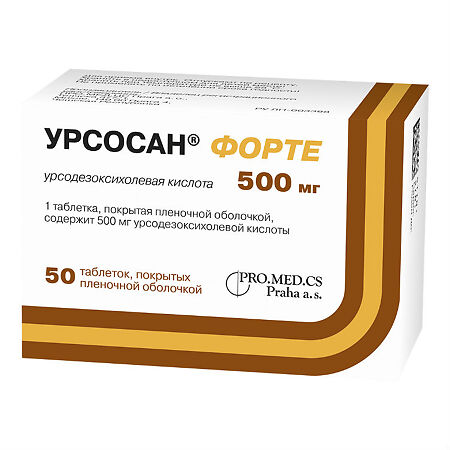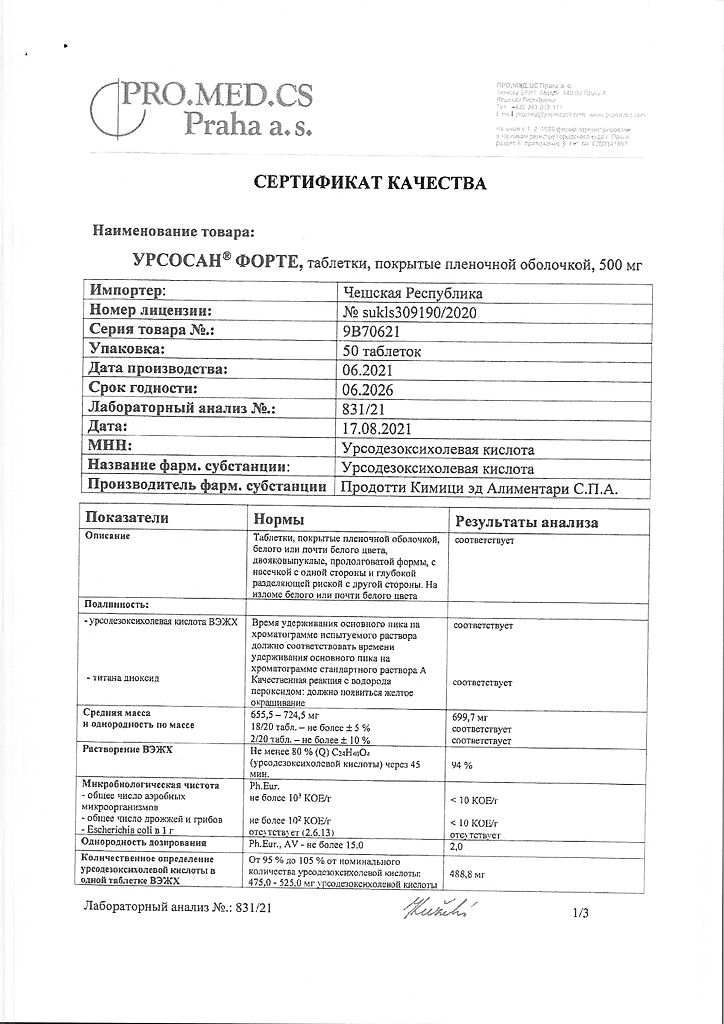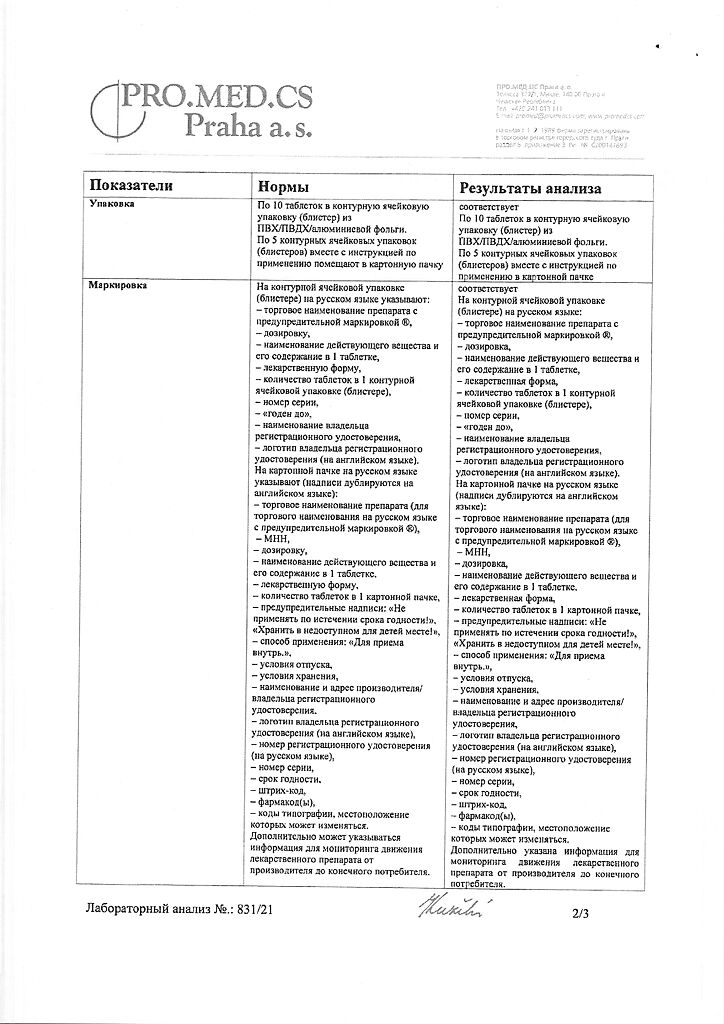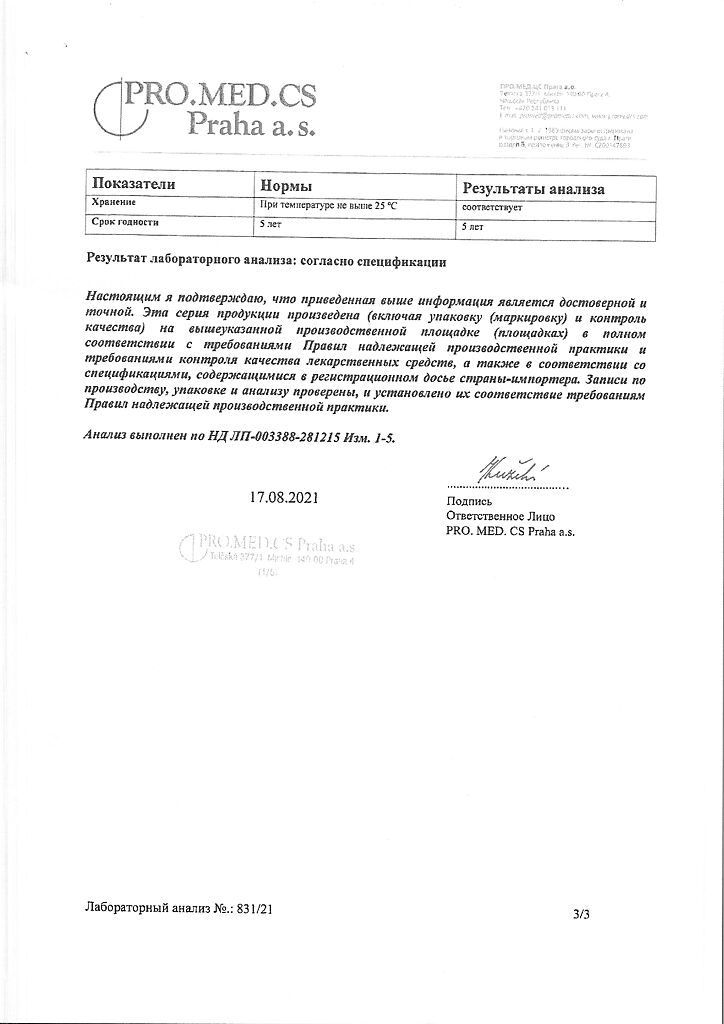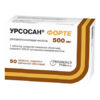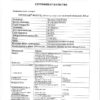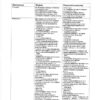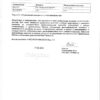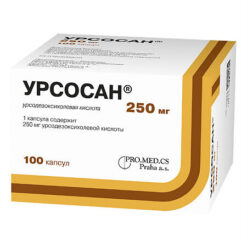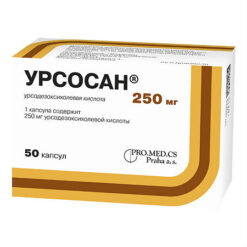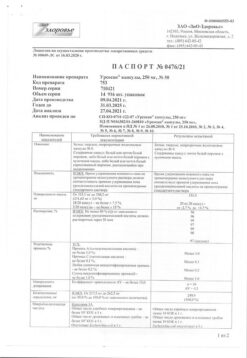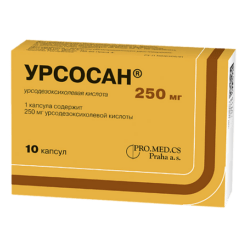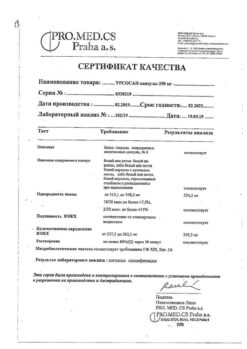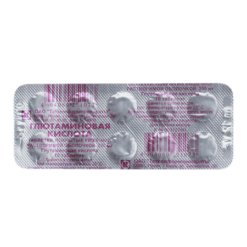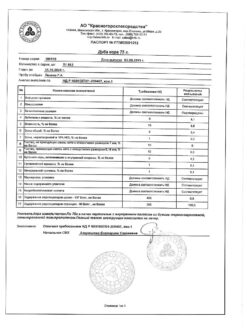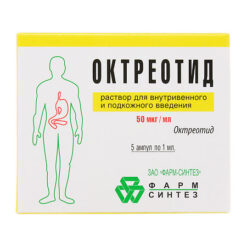No products in the cart.
Ursosan Forte, 500 mg 50 pcs
€49.81 €41.51
Description
Hepatoprotective drug. It also has choleretic, cholitholytic, hypolipidemic, hypocholesterolemic and immunomodulatory effects. Having high polar properties, ursodeoxycholic acid (UDCA) is embedded in the membrane of hepatocyte, cholangiocyte and gastrointestinal epithelial cell, stabilizes its structure and protects the cell from the damaging effects of salts of toxic bile acids, thus reducing their cytotoxic effect.
It forms non-toxic mixed micelles with lipophilic (toxic) bile acids, which reduces the ability of gastric refluxate to damage cell membranes in cholestatic liver diseases, biliary reflux gastritis and reflux esophagitis.
In cholestasis, UDCA activates Ca2-dependent alpha-protease and stimulates exocytosis, reduces the concentration of toxic bile acids (chenodeoxycholic, lithocholic, deoxycholic, etc.), whose concentrations are elevated in patients with chronic liver disease. By reducing their concentrations and stimulating bicarbonate-rich choleresis, UDCA effectively contributes to the resolution of intrahepatic cholestasis. Competitively reduces absorption of lipophilic bile acids in the intestine, increases their “fractional” turnover in enterohepatic circulation, induces choleresis, stimulates the passage of bile and excretion of toxic bile acids through the intestine.
Limits bile saturation with cholesterol due to inhibition of its absorption in intestine, suppression of its synthesis in liver and decrease of secretion into bile; promotes gradual disintegration of cholesterol gallstones, which is achieved mainly due to dispersion of cholesterol and formation of liquid crystals; reduces lithogenic index of bile, increases concentration of bile acids in it. The result is the dissolution of cholesterol gallstones and prevention of formation of new concrements.
Increases gastric and pancreatic secretion, increases lipase activity, and has a hypoglycemic effect.
Immunomodulatory action of UDCA is caused by inhibition of expression of histocompatibility antigens – HLA-1 – on membranes of hepatocytes and HLA-2 – on cholangiocytes; normalization of natural killer activity of lymphocytes, formation of interleukin-2, decrease of eosinophils quantity, suppression of immunocompetent immunoglobulins (Ig), primarily IgM regulation of apoptosis of hepatocytes and epitheliocytes of gastrointestinal tract. Delays the progression of fibrosis.
Indications
Indications
— uncomplicated gallstone disease: biliary sludge; dissolution of cholesterol gallstones with a functioning gallbladder; prevention of recurrent stone formation after cholecystectomy;
— chronic hepatitis of various origins (including toxic, medicinal);
— cholestatic liver diseases of various origins, incl. primary biliary cirrhosis (in the absence of signs of decompensation), primary sclerosing cholangitis, cystic fibrosis (cystic fibrosis);
– non-alcoholic fatty liver disease, incl. non-alcoholic steatohepatitis;
– alcoholic liver disease;
— chronic viral hepatitis;
— biliary dyskinesia;
– biliary reflux gastritis and reflux esophagitis.
Pharmacological effect
Pharmacological effect
Hepatoprotective drug. It also has choleretic, cholelitholytic, hypolipidemic, hypocholesterolemic and immunomodulatory effects. Possessing high polar properties, ursodeoxycholic acid (UDCA) is embedded in the membrane of hepatocytes, cholangiocytes and epithelial cells of the gastrointestinal tract, stabilizes its structure and protects the cell from the damaging effects of toxic bile acid salts, thus reducing their cytotoxic effect.
Forms non-toxic mixed micelles with lipophilic (toxic) bile acids, which reduces the ability of gastric reflux to damage cell membranes in cholestatic liver diseases, biliary reflux gastritis and reflux esophagitis.
In cholestasis, UDCA activates Ca2-dependent alpha protease and stimulates exocytosis, reduces the concentration of toxic bile acids (chenodeoxycholic, lithocholic, deoxycholic, etc.), the concentrations of which are increased in patients with chronic liver diseases. By reducing their concentration and stimulating bicarbonate-rich choleresis, UDCA effectively promotes the resolution of intrahepatic cholestasis. Competitively reduces the absorption of lipophilic bile acids in the intestine, increases their “fractional” turnover during enterohepatic circulation, induces choleresis, stimulates the passage of bile and the excretion of toxic bile acids through the intestine.
Reduces the saturation of bile with cholesterol by inhibiting its absorption in the intestine, suppressing synthesis in the liver and reducing secretion into bile; promotes the gradual disintegration of cholesterol gallstones, which is achieved mainly due to the dispersion of cholesterol and the formation of liquid crystals; reduces the lithogenic index of bile, increases the concentration of bile acids in it. The result is the dissolution of cholesterol gallstones and the prevention of the formation of new stones.
Causes increased gastric and pancreatic secretion, enhances lipase activity, and has a hypoglycemic effect.
The immunomodulatory effect of UDCA is due to inhibition of the expression of histocompatibility antigens – HLA-1 – on the membranes of hepatocytes and HLA-2 – on cholangiocytes, normalization of the natural killer activity of lymphocytes, the formation of interleukin-2, a decrease in the number of eosinophils, suppression of immunocompetent immunoglobulins (Ig), primarily IgM; regulation of apoptosis of hepatocytes and epithelial cells of the gastrointestinal tract. Delays the progression of fibrosis.
Special instructions
Special instructions
The use of the drug for the purpose of dissolving gallstones is possible under the following conditions: the stones must be cholesterol (X-ray negative), their size is no more than 15-20 mm, a functioning gallbladder with preserved patency of the cystic and common bile ducts, filled with gallstones no more than half.
With long-term use of the drug to dissolve gallstones, a biochemical blood test should be performed every 4 weeks in the first 3 months of treatment, and then every 3 months to determine the activity of liver transaminases. Monitoring the effectiveness of treatment should be carried out every 6 months according to ultrasound of the gallbladder and biliary tract.
After complete dissolution of the stones, it is recommended to continue using the drug for 3 months in order to promote the dissolution of remnants of stones, the size of which is too small to detect, and to prevent relapse of stone formation.
Impact on the ability to drive vehicles and machinery
The use of the drug Ursosan does not affect the performance of potentially hazardous activities that require increased concentration of attention and speed of psychomotor reactions (including the ability to drive vehicles, work with moving mechanisms).
Active ingredient
Active ingredient
Ursodeoxycholic acid
Composition
Composition
1 tab. – ursodeoxycholic acid 500 mg
Excipients:
corn starch – 94.5 mg,
pregelatinized corn starch – 48 mg,
sodium carboxymethyl starch (type A) – 13 mg,
colloidal silicon dioxide – 15 mg,
magnesium stearate – 14.5 mg.
Shell composition:
opadry white 03B28796 – 5 mg (hypromellose 6 – 3.13 mg, titanium dioxide – 1.56 mg, macrogol 400 – 0.31 mg).
Pregnancy
Pregnancy
The use of ursodeoxycholic acid during pregnancy is possible only when the expected benefit to the mother outweighs the potential risk to the fetus or newborn (there have been no adequate, strictly controlled studies of the use of ursodeoxycholic acid in pregnant women).
Contraindications
Contraindications
– hypersensitivity to the active and auxiliary components of the drug;
– X-ray positive (high calcium content) gallstones;
– non-functioning gallbladder;
– acute inflammatory diseases of the gallbladder, bile ducts and intestines;
— liver cirrhosis in the stage of decompensation;
– severe renal dysfunction;
– severe liver dysfunction;
– severe dysfunction of the pancreas.
Ursodeoxycholic acid has no age restrictions for use, however, it is not recommended to use the drug in this dosage form in children under 3 years of age.
Side Effects
Side Effects
Determination of the frequency of side effects (number of cases/number of observations): very often (≥1/10); often (≥1/100 to <1/10); uncommon (≥1/1000 to <1/100); rare (≥1/10,000 to <1/1000); very rare (< 1/10,000), frequency cannot be calculated from available data.
From the digestive system: in clinical studies, diarrhea or pasty stools were often observed during treatment with ursodeoxycholic acid. In the treatment of primary biliary cirrhosis, severe pain in the upper abdomen has been very rarely reported.
From the liver and biliary tract: during treatment with ursodeoxycholic acid, in very rare cases, calcification of gallstones was observed.
When treating primary biliary cirrhosis in the later stages, in very rare cases decompensation of liver cirrhosis was observed, which regressed after cessation of treatment.
From the skin and subcutaneous tissues: in very rare cases, urticaria may occur.
Interaction
Interaction
The drug should not be used simultaneously with antacids containing aluminum or ion exchange resins (colestyramine, colestipol), since these drugs may reduce the absorption of ursodeoxycholic acid. If necessary, these drugs should be taken 2 hours before or 2 hours after taking UDCA.
Some medications, such as estrogens, progestogens (oral contraceptives), neomycin, clofibrate, can increase cholelithiasis, thereby having the opposite effect of the ability of ursodeoxycholic acid to dissolve cholesterol gallstones.
Ursodeoxycholic acid may increase the absorption of cyclosporine from the intestine, which requires monitoring the concentration of cyclosporine in the blood plasma and, if necessary, adjusting its dosage regimen.
In some cases, ursodeoxycholic acid may reduce the absorption of ciprofloxacin.
Overdose
Overdose
Symptoms: In case of overdose, diarrhea may occur.
Other symptoms of overdose are unlikely because the resorption of ursodeoxycholic acid worsens as the dose increases, leading to increased excretion in the feces.
Treatment: in case of established, prolonged diarrhea, drug therapy should be discontinued. Treatment is symptomatic.
Storage conditions
Storage conditions
Tablets should be stored protected from light and at a temperature of 15° to 25°C.
Shelf life
Shelf life
3 years.
Manufacturer
Manufacturer
PRO.MED.CS Prague, Czech Republic
Additional information
| Shelf life | 3 years. |
|---|---|
| Conditions of storage | The tablets should be stored in a place protected from light and at a temperature of 15 ° to 25 ° C. |
| Manufacturer | PRO.MED.CS Prague, Czech Republic |
| Medication form | pills |
| Brand | PRO.MED.CS Prague |
Other forms…
Related products
Buy Ursosan Forte, 500 mg 50 pcs with delivery to USA, UK, Europe and over 120 other countries.

